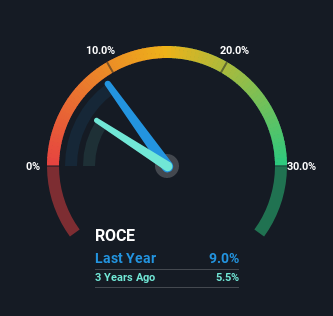Swiss Water Decaffeinated Coffee (TSE:SWP) Has Some Way To Go To Become A Multi-Bagger
Did you know there are some financial metrics that can provide clues of a potential multi-bagger? One common approach is to try and find a company with returns on capital employed (ROCE) that are increasing, in conjunction with a growing amount of capital employed. Ultimately, this demonstrates that it's a business that is reinvesting profits at increasing rates of return. Having said that, from a first glance at Swiss Water Decaffeinated Coffee (TSE:SWP) we aren't jumping out of our chairs at how returns are trending, but let's have a deeper look.
Understanding Return On Capital Employed (ROCE)
For those who don't know, ROCE is a measure of a company's yearly pre-tax profit (its return), relative to the capital employed in the business. The formula for this calculation on Swiss Water Decaffeinated Coffee is:
Return on Capital Employed = Earnings Before Interest and Tax (EBIT) ÷ (Total Assets - Current Liabilities)
0.09 = CA$12m ÷ (CA$200m - CA$65m) (Based on the trailing twelve months to June 2022).
Thus, Swiss Water Decaffeinated Coffee has an ROCE of 9.0%. In absolute terms, that's a low return, but it's much better than the Food industry average of 7.4%.
Check out our latest analysis for Swiss Water Decaffeinated Coffee

While the past is not representative of the future, it can be helpful to know how a company has performed historically, which is why we have this chart above. If you want to delve into the historical earnings, revenue and cash flow of Swiss Water Decaffeinated Coffee, check out these free graphs here.
The Trend Of ROCE
In terms of Swiss Water Decaffeinated Coffee's historical ROCE trend, it doesn't exactly demand attention. The company has consistently earned 9.0% for the last five years, and the capital employed within the business has risen 111% in that time. Given the company has increased the amount of capital employed, it appears the investments that have been made simply don't provide a high return on capital.
On another note, while the change in ROCE trend might not scream for attention, it's interesting that the current liabilities have actually gone up over the last five years. This is intriguing because if current liabilities hadn't increased to 33% of total assets, this reported ROCE would probably be less than9.0% because total capital employed would be higher.The 9.0% ROCE could be even lower if current liabilities weren't 33% of total assets, because the the formula would show a larger base of total capital employed. With that in mind, just be wary if this ratio increases in the future, because if it gets particularly high, this brings with it some new elements of risk.
In Conclusion...
As we've seen above, Swiss Water Decaffeinated Coffee's returns on capital haven't increased but it is reinvesting in the business. Since the stock has declined 43% over the last five years, investors may not be too optimistic on this trend improving either. On the whole, we aren't too inspired by the underlying trends and we think there may be better chances of finding a multi-bagger elsewhere.
If you want to know some of the risks facing Swiss Water Decaffeinated Coffee we've found 4 warning signs (3 are significant!) that you should be aware of before investing here.
While Swiss Water Decaffeinated Coffee may not currently earn the highest returns, we've compiled a list of companies that currently earn more than 25% return on equity. Check out this free list here.
New: Manage All Your Stock Portfolios in One Place
We've created the ultimate portfolio companion for stock investors, and it's free.
• Connect an unlimited number of Portfolios and see your total in one currency
• Be alerted to new Warning Signs or Risks via email or mobile
• Track the Fair Value of your stocks
Have feedback on this article? Concerned about the content? Get in touch with us directly. Alternatively, email editorial-team (at) simplywallst.com.
This article by Simply Wall St is general in nature. We provide commentary based on historical data and analyst forecasts only using an unbiased methodology and our articles are not intended to be financial advice. It does not constitute a recommendation to buy or sell any stock, and does not take account of your objectives, or your financial situation. We aim to bring you long-term focused analysis driven by fundamental data. Note that our analysis may not factor in the latest price-sensitive company announcements or qualitative material. Simply Wall St has no position in any stocks mentioned.
About TSX:SWP
Swiss Water Decaffeinated Coffee
Engages in the decaffeination of green coffee without the use of chemicals in Canada, the United States, and internationally.
Proven track record with low risk.
Market Insights
Community Narratives



